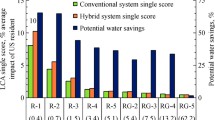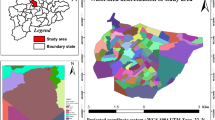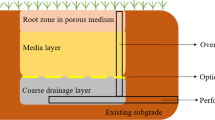Abstract
Low-impact development (LID) practices are gaining popularity as an approach to manage stormwater close to the source. LID practices reduce infrastructure requirements and help maintain hydrologic processes similar to predevelopment conditions. Studies have shown LID practices to be effective in reducing runoff and improving water quality. However, little has been done to aid decision makers in selecting the most effective practices for their needs and budgets. The long-term hydrologic impact assessment LID model was applied to four neighborhoods in Lafayette, Indiana using readily available data sources to compare LID practices by analyzing runoff volumes, implementation cost, and the approximate period needed to achieve payback on the investment. Depending on the LID practice and adoption level, 10–70 % reductions in runoff volumes could be achieved. The cost per cubic meter of runoff reduction was highly variable depending on the LID practice and the land use to which it was applied, ranging from around $3 to almost $600. In some cases the savings from reduced runoff volumes paid back the LID practice cost with interest in less than 3 years, while in other cases it was not possible to generate a payback. Decision makers need this information to establish realistic goals and make informed decisions regarding LID practices before moving into detailed designs, thereby saving time and resources.





Similar content being viewed by others
References
Ahiablame LM, Engel BA, Chaubey I (2012) Representation and evaluation of low impact development practices with L-THIA-LID: an example for site planning. Environ Pollut 1:1–13
Ahiablame LM, Engel BA, Chaubey I (2013) Effectiveness of low impact development practices in two urbanized watersheds: retrofitting with rain barrel/cisterns and porous pavements. J Environ Manage 119:151–161
Ando AW, Freitas LPC (2011) Consumer demand for green stormwater management technology in an urban setting: the case of Chicago rain barrels. Water Resour Res 47:1–11
Banting D, Doshi H, Li J, Missios P, Au A, Currie BA, Verrati M (2005) Report on the environmental benefits and costs of green roof technology for the city of Toronto. Ryerson University, Toronto
Bean EZ, Hunt WF, Bidelspach DA (2007) Evaluation of four permeable pavement sites in eastern North Carolina for runoff reduction and water quality impacts. J Irrig Drain Eng 133:583–592
Bhaduri B, Grove M, Lowry C, Harbor J (1997) Assessing the longterm hydrological impact of land-use change: cuppy-mcclure watershed. Indiana J Am Water Works Assoc 89:94–106
Bianchini F, Hewage K (2012) How “green” are green roofs? Lifecycle analysis of green roof materials. Build Environ 48:57–65
Boulware EWB (2004) Harvesting the rain: considering rainwater catchment as a domestic source. Plumb Syst Des, pp 42–45
Brattebo BO, Booth DB (2003) Long-term stormwater quantity and quality performance of permeable pavement systems. Water Res 37:4369–4376
Brinkman E, Seekamp E, Davenport MA, Brehm JM (2012) Community capacity for watershed conservation: a quantitative assessment of indicators and core dimensions. Environ Manage 50(4):736–749
Cahill TH, Adams M, Marm C (2003) Porous asphalt: the right choice for porous pavements. Hot Mix Asphalt Technol, pp 26–40
Carter T, Butler C (2008) Ecological impaacts of replacing traditional roofs with green roofs in two urban areas. Cities Environ 1:1–17
Carter T, Fowler L (2008) Establishing green roof infrastructure through environmental policy instruments. Environ Manage 42(1):151–164
Choi W (2007) Estimating land-use change impacts on direct runoff and non-point source pollutant loads in the Richland Creek basin (Illinois, USA) by applying the L-THIA model. J Spatial Hydrol 7:47–65
CNT (Center for Neighborhood Technology) (2009) National green values (tm) calculator methodology. Center for Neighborhood Technology, Chicago
Davis AP (2005) Green engineering principles promote low-impact development. Environ Sci Technol 39:338A–344A
Davis AP (2008) Field performance of bioretention: hydrology impacts. J Hydrol Eng 13:90–95
Davis AY, Pijanowski BC, Robinson K, Engel BA (2010) The environmental and economic costs of sprawling parking lots in the United States. Landuse Policy 27:255–261
Dietz ME (2007) Low impact development practices: a review of current research and recommendations for future directions. Water Air Soil Poll 186:351–363
Dietz ME, Clausen JC, Filchak KK (2004) Education and changes in residential nonpoint source pollution. Environ Manage 34(5):684–690
Engel BA (2001) L-THIA NPS long-term hydrologic impact assessment non point source pollutant model. Purdue University, West Lafayette
Engel BA, Ahiablame L (2011) L-THIA LID long-term hydrologic impact assessment low impact development model. Visual basic application. Purdue University, West Lafayette
Engel BA, Hunter J (2009) L-THIA LID long-term hydrologic impact assessment low impact development model. Spreadsheet version. Purdue University, West Lafayette
ESD DER (2007) Bioretention manual. Environmental services division, department of environmental resources, Prince George’s County, Maryland
Grove M, Harbor J, Engel BA, Muthukrishnan S (2001) Impacts of urbanization on surface hydrology, little eagle creek, indaina, and analysis of LTHIA model sensitivity to data resolution. Phys Geogr 22:135–153
Gunderson J, Roseen R, Janeski T, Houle J, Simpson M (2011) Economical CSO management. Stormwater 12:10–25
Gunn R, Martin A, Engel B, Ahiablame L (2012) Development of two indices for determining hydrologic implications of land use changes in urban areas. Urban Water J 9:239–248
Harbor JM (1994) A practical method for estimating the impact of land-use change on surface runoff, groundwater recharge, and wetland hydrology. J Am Plann Assoc 60:95–108
Hatt BE, Fletcher TD, Walsh CJ, Taylor SL (2004) The influence of urban density and drainage infrastructure on the concentrations and loads of pollutants in small streams. Environ Manage 34(1):112–124
Houdeshel C, Pomeroy C, Hair L, Moeller J (2011) Cost-estimating tools for low-impact development best management practices: challenges, limitations, and implications. J Irrig Drain Eng 137:183–189
Houle J, Roseen R, Ballestero T, Puls T, Sherrard J (2013) Comparison of maintenance cost, labor demands, and system performance for LID and conventional stormwater management. J Environ Eng 139:932–938
Hunt WF, Smith JT, Jadlocki SJ, Hathaway JM, Eubanks PR (2008) Pollutant removal and peak flow mitigation by a bioretention cell in urban charlotte, N.C. J Environ Eng 134:403–408
Keeley M, Koburger A, Dolowitz DP, Medearis D, Nickel D, Shuster W (2013) Perspectives on the use of green infrastructure for stormwater management in cleveland and milwaukee. Environ Manage 51(6):1093–1108
Lim KJ, Engel BA, Muthukrishnan S, Harbor J (2006a) Effects of initial abstraction and urbanization on estimated runoff using CN technology. J Am Water Resour As 42:629–643
Lim KJ, Engel BA, Tang Z, Muthukrishnan S, Choi J, Kim K (2006b) Effects of calibration on L-THIA GIS runoff and pollutant estimation. J Environ Manage 78:35–43
Liu Y, Ahiablame LM, Bralts VF, Engel BA (2015a) Enhancing a rainfall-runoff model to assess the impacts of BMPs and LID practices on storm runoff. J Environ Manage 147:12–23. doi:10.1016/j.jenvman.2014.09.005
Liu Y, Bralts VF, Engel BA (2015b) Evaluating the effectiveness of management practices on hydrology and water quality at watershed scale with a rainfall-runoff model. Sci Total Environ 511:298–308. doi:10.1016/j.scitotenv.2014.12.077
Mentens J, Raes D, Hermy M (2006) Green roofs as a tool for solving the rainwater runoff problem in the urbanized 21st century? Landscape Urban Plan 77:217–226
Montalto F, Behr C, Alfredo K, Wolf M, Arye M, Walsh M (2007) Rapid assessment of the cost-effectiveness of low impact development for CSO control. Landscape Urban Plan 82:117–131
NCSU (2011) Urban waterways—maintaining permeable pavements (No. AG-588-23 W). North Carolina State University and North Carolina A&T State University Cooperative Extension, Raleigh
NRCS (1986) Urban hydrology for small watershed (Technical Release No. 55). USDA Natural resources conservation services, Washington
Pandey S, Gunn R, Lim K, Engel B, Harbor J (2000) Developing a web-enabled tool to assess long-term hydrologic impact of land use change: information technologies issues and a case atudy. J Urban and Reg Inf Syst Assoc 12:5–17
Roseen RM, Ballestro TP, Houle JJ, Briggs JF, Houle KM (2012) Water quality and hydrologic performance of a porous asphalt pavement as a storm-water treatment stratagy in a cold climate. J Environ Eng 138:81–89
Rowe DB (2011) Green roofs as a means of pollution abatement. Environ Pollut 159:2100–2110
Roy AH, Wenger SJ, Fletcher TD, Walsh CJ, Ladson AR, Shuster WD, Thurston HW, Brown RR (2008) Impediments and solutions to sustainable, watershed-scale urban stormwater management: lessons from Australia and the United States. Environ Manage 42(2):344–359
Sample DJ, Heaney JP, Wright LT, Koustas R (2001) Geographic information systems, decision support systems, and urban storm-water management. J Water Resour Plan and Manage 127(3):155–161.
SEMCOG (2008) Low impact development manual for michigan: a design guide for implementers and reviewers. Southeast Michigan Council of Governments, Detroit
Tang Z, Engel BA, Pijanowski BC, Lim KJ (2005) Forecasting land use change and its environmental impact at a watershed scale. J Environ Manage 76:35–45
TunnelTalk (2009) Lafayette CSO breakthrough [WWW Document]. TunnelTalk. http://www.tunneltalk.com/LafayetteCSO-Jul09-Lafayette-CSO-breakthrough.php. Accessed 23 May 2013
US Army Corps of Engineers Train the Trainer Manual (2012) L-THIA LID tutorials
USACE (2012) U.S. army corps of engineers train the trainer manual. U.S. Army Corps of Engineers, Detroit
USDA NRCS (2011) Soil survey geographic (SSURGO) database for Tippecanoe County
USEPA (2003) Protecting water quality from urban runoff (No. EPA 841-F-03-003). U.S Environmental Protection Agency, Washington
USEPA (2004) Report to congress: impacts and control of CSOs and SSOs (No. EPA 833-R-04-001). U.S Environmental Protection Agency, Washington
USEPA (2005) Bioretention (Rain Gardens) [WWW Document]. EPA—stormwater menu BMPs. http://cfpub.epa.gov/npdes/stormwater/menuofbmps/index.cfm?action=browse. Accessed 21 August 2013
USEPA (2007) Reducing stormwater costs through low impact develeopment (LID) strategies and practices (No. EPA 841-F-07-006). U.S Environmental Protection Agency, Washington
USEPA (2008) Green roofs [WWW Document]. EPA—stormwater menu BMPs. http://cfpub.epa.gov/npdes/stormwater/menuofbmps/index.cfm?action=factsheet_results&view=specific&bmp=114. Accessed 11 Sep 2013
Wright TJ (2014) Retrofitting LID practices into existing neighborhoods: is it worth it?. Purdue University, West Lafayette
Yu Z, Aguayo M, Montalto F, Piasecki M, Behr C (2010) Developments in LIDRA 2.0: a planning level assessment of the cost-effectiveness of low impact development. In: World environmental and water resources congress. pp 3261–3270
Acknowledgments
We thank Purdue University for financial support to conduct this research. We thank Mr. Larry Theller for his assistance with data used in this research.
Author information
Authors and Affiliations
Corresponding author
Rights and permissions
About this article
Cite this article
Wright, T.J., Liu, Y., Carroll, N.J. et al. Retrofitting LID Practices into Existing Neighborhoods: Is It Worth It?. Environmental Management 57, 856–867 (2016). https://doi.org/10.1007/s00267-015-0651-5
Received:
Accepted:
Published:
Issue Date:
DOI: https://doi.org/10.1007/s00267-015-0651-5




